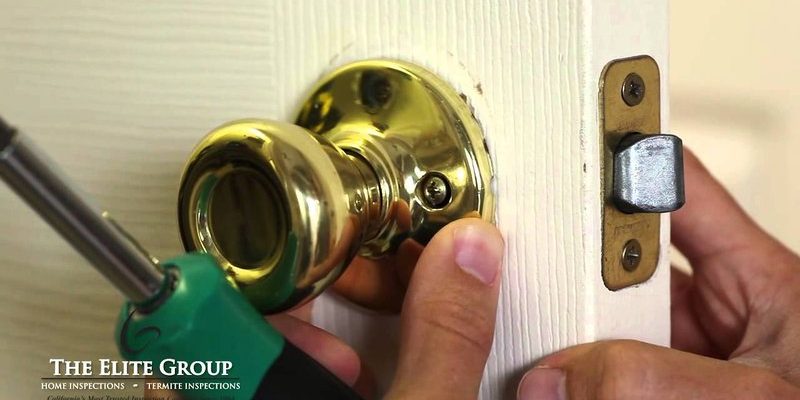
A door knob, whether it’s traditional or a modern smart version, works on a simple principle. When you turn the knob, it should pull the latch back, allowing you to open the door. If that latch isn’t retracting all the way, it could be due to several reasons, from simple misalignment to deeper mechanical issues. Let’s dive into common causes and how to tackle them effectively.
Common Reasons for Latch Issues
When a door knob doesn’t retract the latch fully, it usually boils down to a few common culprits. Let’s explore some of the most frequent causes and how you can identify them.
Misalignment of the Door or Frame
One of the primary reasons your door knob might not be working correctly is misalignment. Doors can shift over time due to temperature changes, humidity, or even just regular wear and tear. Imagine a book sliding out of place on a shelf; it just doesn’t sit right anymore.
Check if the door sits evenly within the frame. If it’s sagging or out of position, it could be causing your latch to bind against the strike plate (the metal piece on the frame). You might notice that the door doesn’t close tightly. Adjusting the hinges can help realign the door and allow the latch to retract smoothly.
Worn or Damaged Components
Another issue could be worn or damaged parts within the door knob itself. Just like a bicycle that can’t pedal smoothly if its chain is rusted, your door knob also needs all its parts in good shape to function correctly.
Verify that the internal mechanism of the door knob, including the latch and the connecting rod, are intact. Sometimes, lubrication helps, but if you see any broken components, you might need to replace the whole knob or just specific parts.
Checking the Installation
Improper installation can also lead to latch issues. If you’ve recently installed a new door knob or replaced an existing one, the problem might lie in how it was set up.
Incorrect Positioning of the Latch
When installing a door knob, the latch needs to align perfectly with the strike plate. If it’s even slightly off, it won’t retract fully. This can happen if the hole for the latch isn’t drilled deep enough, or if the door knob itself isn’t positioned straight.
To fix this, you might need to take the knob off and reposition the latch. It can be a little tricky, but it’s mostly about getting the right alignment. Don’t hesitate to ask a friend for a hand if you need it!
Using the Wrong Door Knob for Your Door
Sometimes, using the wrong type of door knob can lead to functional issues. If you’re trying to fit a knob designed for a different thickness or style of door, it might not work properly. Think of it like trying to wear shoes that are too small—no matter how hard you try, they just won’t fit right.
Make sure the door knob you’ve chosen matches your door specifications. If you’re unsure, a visit to your local hardware store or a quick online search can clarify what type you need.
Lubrication and Maintenance
Regular maintenance can be crucial. Just like you’d oil a squeaky door hinge, your door knob benefits from a little TLC now and then.
Applying Lubrication
If the latch is sticking, applying some lubricant to the mechanism can work wonders. Use a silicone spray or graphite lubricant, as these can penetrate better without leaving a messy residue.
Simply spray or apply a small amount into the keyhole and around the latch mechanism. After that, turn the knob several times to spread it around. This simple step can often resolve issues of a sticking or slow-retracting latch.
Cleaning Out Debris
Sometimes, dirt and debris can build up inside the door knob or latch, causing it to jam. Regularly cleaning the latch area can prevent future issues. Use a small brush or compressed air to clean out any dirt or dust.
This routine maintenance can help keep your door knob functioning smoothly for years to come. It’s much easier to perform a quick clean than to deal with a jammed latch when you’re running late!
When to Call a Professional
While many issues can be resolved easily, there are times when it’s best to call in a professional.
Identifying Complex Problems
If you’ve tried the above solutions and your door knob still isn’t working, it might be a sign of a more significant problem. Sometimes, the internal mechanisms are just too worn out, or there might be deeper structural issues with your door frame that require expert attention.
You might be thinking, “Can’t I just fix this myself?” While DIY is fantastic, knowing when to ask for help can save you time and more significant issues down the road.
Finding the Right Professional
When looking for a locksmith or handyman to help, make sure to search for someone with good reviews and genuine expertise. This is especially important if you’re not sure what’s wrong. A knowledgeable professional can diagnose the issue quickly and suggest the best course of action.
Wrapping Up Your Door Knob Troubles
If your door knob is not retracting the latch fully, don’t worry. While it can be annoying, most issues are fixable with a little troubleshooting and maintenance. Check for misalignment, worn components, and keep your door knob clean and lubricated.
In some cases, if the problem persists, calling for help is a smart choice. Remember, your door knob’s job is to keep your home secure, and fixing it ensures that it does its job well. With just a little effort, you can get back to enjoying the peace of mind that comes with a smoothly functioning door.
